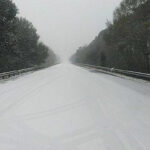Yellowstone National Park in winter transforms into a breathtaking snow-covered wonderland, offering a unique and serene experience compared to the bustling summer months. If you’re seeking a true wintry escape, understanding the nuances of each winter month is key to planning the Best Time To Travel To Yellowstone for your ideal adventure. Let’s delve into a month-by-month guide to help you decide when to witness Yellowstone’s winter magic.
January: Embrace the Heart of Winter
January in Yellowstone is synonymous with a true winter experience. Expect frigid temperatures, with average highs around 28°F (-2°C), and landscapes blanketed in deep snow. Valley floors can accumulate significant snowfall, often reaching 2-3 feet, creating a pristine white canvas. Packing waterproof, insulated boots and a well-insulated, waterproof jacket is crucial to comfortably navigate this snowy terrain.
Despite the cold, January often boasts clear skies due to consistent below-freezing temperatures, making it ideal for capturing stunning winter scenery. Moreover, the snow-covered landscape provides an exceptional backdrop for wildlife viewing. The stark white environment makes it easier to spot animals like wolves against the snow, offering incredible opportunities for wildlife photography and observation. For those interested in guided experiences, winter wildlife safaris are particularly rewarding in January.
February: Witness Wildlife Courtship and Bison Herds
As February arrives, the winter chill persists, but a different kind of energy permeates the Greater Yellowstone Ecosystem. This month marks the breeding season for native canines like red foxes, coyotes, and gray wolves. Visiting Yellowstone in February offers the chance to observe these fascinating animals engaging in courtship behaviors, a truly special wildlife spectacle. Prepare for continued below-freezing temperatures and potential blizzards by packing warm, waterproof layers.
Another highlight of February is the increased visibility of bison. To survive the harsh winter conditions, bison grow thick winter coats and migrate to lower elevations, congregating in areas like Mammoth Hot Springs and the Lamar Valley. These areas offer less snow, making foraging easier for these massive creatures. February is an excellent time to capture iconic photographs of bison with snow-covered faces, a quintessential Yellowstone winter image.
March: Spring Hints and Wildlife Transitions
March signals the subtle shift from deep winter to the promise of spring in Yellowstone. Average high temperatures creep up to 39°F (3.8°C), just above freezing, initiating some snow and ice melt. This can result in slushy and muddy conditions, so waterproof boots remain essential.
By mid-March, around the 15th, snowmobile and snowcoach access into Yellowstone National Park typically concludes. If you’re planning a winter tour utilizing over-snow travel, ensure your visit is before this date. March also marks the beginning of elk antler shedding season. Male elk shed their antlers, impressive bony structures that can weigh up to 30 pounds each, annually. While the antlers are regrowing, observing elk without their full racks is another unique aspect of Yellowstone in March.
Conclusion: Choosing Your Best Time
Ultimately, the best time to travel to Yellowstone in winter depends on your priorities. January offers the quintessential deep winter experience with pristine snow and excellent wildlife visibility against the white backdrop. February provides opportunities to witness canine courtship and large bison herds. March offers a glimpse of spring’s arrival and unique wildlife behaviors like elk antler shedding. No matter which winter month you choose, Yellowstone’s serene beauty and unique wildlife encounters are sure to create an unforgettable experience.

